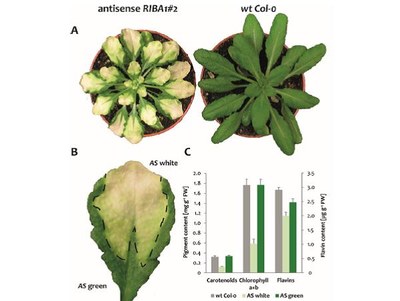Riboflavin Biosynthesis
Patrick Schall, Hanna Hiltunen, Boris Hedtke
Plants and microorganisms synthesize riboflavin (also referred to as vitamin B2)and are an important source of riboflavin for the human diet. Riboflavin serves as a precursor for flavin mononucleotide (FMN) and flavin adenine dinucleotide (FAD), which are involved as main redox coenzymes in central metabolic processes. They are originated from riboflavin. We are interested to explore the metabolic pathway of the synthesis of flavocoenzymes. We begann our studies with the two committed enzymatic steps of riboflavin biosynthesis, which are performed in plants by bifunctional RIBA enzymes comprised of GTP cyclohydrolase II (GCHII) and 3,4-dihydroxy-2-butanone-4-phosphate synthase (DHBPS).

Panel A depicts eight-week-old Arabidopsis wild-type and RIBA1-antisense lines grown under short-day condition (100 µmol photons m-2 s-1). Panel B shows the close-up of a bleached leaf of the antisense line and the labelled sectors used for pigments and flavin analysis presented in panel C (n=3). Copied from the doctoral thesis of Hanna Hiltunen, Humboldt-Universität Berlin.
We expect to obtain information about RIBA isoforms and other important mono- and bifunctional proteins of the pathway with regard to their
- physiological role in plant riboflavin biosynthesis and
- assembly with other enzymes of the pathway and auxiliary proteins of riboflavin biosynthesis in macromolecular complexes.
- initial posttranslational modifications.